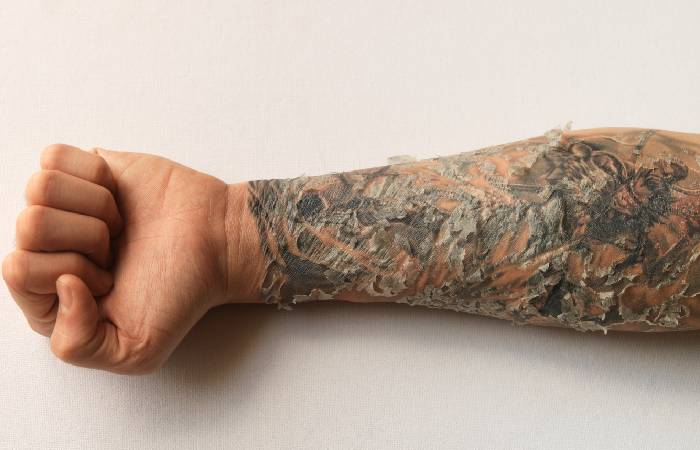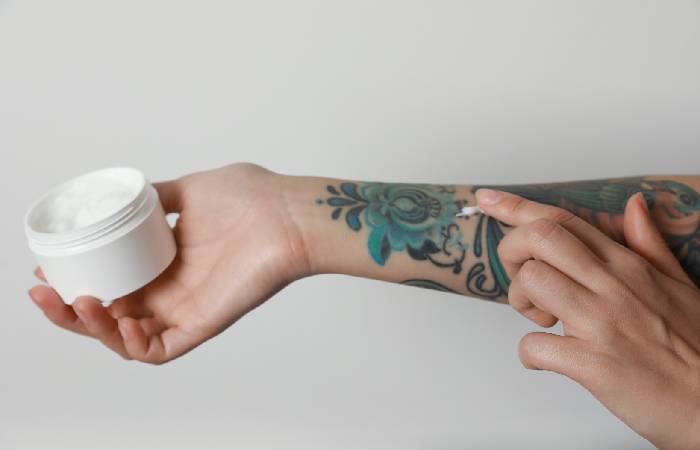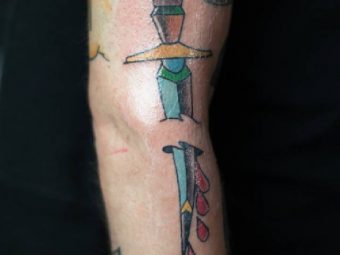Shiny Tattoo: Causes, Concerns, And What To Do
Discover how your shiny tattoo is a sign that your favorite body art is going to shine!

Image: Shutterstock
Getting a fresh tattoo and witnessing a layer of gloss develop on it may have got you thinking, ‘Why is my tattoo shiny?’ In fact, this may seem truly alarming for individuals who are getting inked for the first time. However, the glossy sheen on your tattoo is a common outcome of the intricate healing process and tattoo aftercare practices. In the initial healing phase, scabs form on the new tattoo, which eventually shed and then reveal the fresh layers of regenerated skin beneath. This fresh skin along with the constant application of tattoo ointments and moisturizers can lead to the common sheen on the tattoo, also referred to as “onion skin”. This is a normal part of the healing phase that contributes to the tattoo’s longevity and vibrancy and does not call for any extreme measures or concern. Continue scrolling as we understand this process in detail to make your tattoo healing journey smoother.
In This Article
Why Is My Tattoo Shiny?
The sheen on the fresh tattoo is an integral part of the tattoo healing phase and is known as renewed skin. Tattoos are basically wounds that go through the natural process of recovery. This causes the formation of scabs on the tattooed skin, which sloughs off and gives way to fresh, glossy skin. But this entire process consists of a few steps. Let us understand what exactly happens to the skin during the process in the section below.
What Happens To My Skin While The Tattoo Heals?
Once the fresh tattoo is inked, the healing process begins. You can expect the formation of scabs from the first week onwards. These scabs on the tattoo dry and naturally shed off by the second or third week, leaving a shiny layer on your tattoo, known as the onion skin stage. This effect results from the healed skin’s smooth texture and the vibrancy of the tattoo ink underneath. From day one to three and four, the new tattoo gets rid of excess blood, plasma, and ink from the wound. And, once the protective film is removed, the proper healing phase begins.
 Quick Tip
Quick TipWhile a shiny tattoo is normal, certain concerns can be associated with it as well. Let us read about it below.
Concerns About Shiny Tattoos
If your tattoo stays shiny for longer than usual, it may result in or be caused by the following factors.
- Skin Infection
Excess shine on the skin might not be a cause of skin infection. However, sometimes it can be an early indication of possible redness, inflammation, and discharge.
- Allergic Reactions
It is common for those with sensitive skin types to experience an allergic reaction that can lead to itchiness, redness, swelling, and a shiny layer on the area.
- Excess Use Of Healing Products
Using excessive amounts of healing products like ointments, balms, and moisturizers can result in over-moisturizing a tattoo, contributing to its shiny appearance.
- Color Fading
Prolonged shine can also indicate improper healing and result in premature color fading of the tattoo.
When you see a shiny tattoo, there are certain steps you can take to boost the healing process while protecting the colors. Read on to learn more about it.
What To Do When My Tattoo Becomes Shiny?
There are certain measures you can take if you are noticing unwanted shine on your tattoo.
- Use a fragrance-free, mild soap to clean the tattoo.
- Refrain from over-moisturizing a tattoo and only apply a thin layer of the healing ointment or tattoo balm.
- Avoid direct sun exposure and shield the tattoo to prevent color fading.
Another question that comes to one’s mind during this process is how long will the shine last and what time period is considered normal and healthy, so let us read about it below.
How Long Does The “Onion Tattoo Skin” Phase Last During The Healing Process?
This shiny phase may take about 2 to 4 weeks but will eventually lead to a matte yet vibrant piece of body art once fully recovered. Once the shiny stage is gone, you may witness your new tattoo looking slightly faded and cloudy, which is a healthy sign that your skin is returning to its normal state.
A blogger talks about his personal experience with getting inked and the whole healing phase. He recounts in his blog post and proceeds to share some tips as well, “The bepanthen must be used 3-4 times a day for 2 weeks. Your tattoo won’t be 100% healed until 2 weeks, give or take a few days. You know it is healed when it has stopped peeling and the skin goes shiny, the bright vibrant colours will also dull a bit but don’t worry about that (i).”
 Quick Tip
Quick TipNow, you may be wondering what to expect after the healing time is over. To understand it better, let us check out the section below.
What To Expect After Your Tattoo Heals
Once the tattoo has gone past the onion skin phase, indicating complete healing, there are certain things you can expect:
- The excess discomfort or pain initially experienced during the healing phase will subside.
- The tattoo will have a smooth texture free of scabs.
- The design will appear like your normal skin with no unnecessary sheen on it.
These are the common signs of optimal healing. However, you can always consult your professional tattoo artist in case you are not satisfied with the outcome and still have minor concerns.
Anyone can feel a little perplexed after seeing a shiny layer on their new tattoo, but the reassuring part is that this phase does not call for any concerns. It is a normal and crucial part of the tattoo healing process. The onion tattoo skin phase occurs after the peeling and shedding of the scabs, which involves the emergence of regenerated skin and a slightly glossy appearance. But then again, the excess of everything is also not ideal. Hence, closely monitor the healing process, watch out for signs of skin infection, and follow a proper care routine for a vibrant tattoo design and desired outcome.
Frequently Asked Questions
What to do if my tattoo is still shiny after 4 months?
While a tattoo may take a good 4 to 6 months for proper healing, if you still notice a shine on your tattoo, consult your tattoo artist or a dermatologist to address any potential issues.
What is the silver skin stage of a tattoo?
The second week after getting a new tattoo is commonly referred to as the silver skin stage as the skin forms natural scabs on the inked area, which appears slightly shiny and silvery.
Key Takeaways
- A shiny tattoo is a part of the natural tattoo healing process and occurs after the shedding of scabs.
- The regeneration of the skin cells and tissues causes such a result and makes the tattoo appear glossy.
- Prolonged shine may raise concerns such as the risk of infection, uneven healing, color fading, and over-moisturizing.
- The shiny layer on the tattoo is also commonly referred to as onion skin.
For the ones getting inked for the first time, the healing process can seem a little confusing. So, check out the video below as it talks about the complete healing phase in detail and explains when to expect your tattoo to have a shiny appearance.
Personal Experience: Sources
(i) Getting Inked – My Tattoo Experience
https://hillsandwhitewater.wordpress.com/2015/09/03/getting-inked-my-tattoo-experience/





























